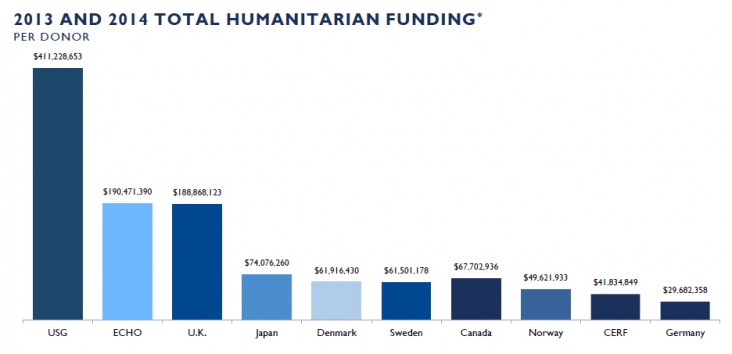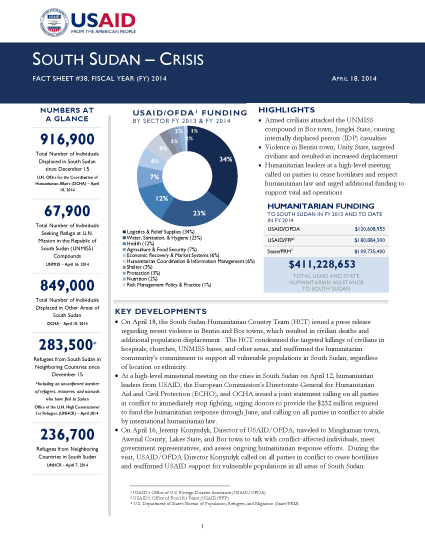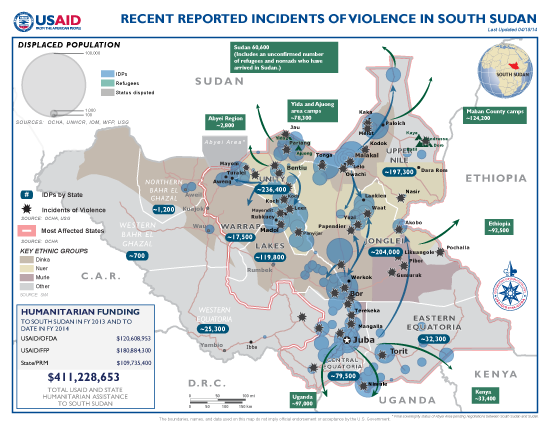- What We Do
- Agriculture and Food Security
- Democracy, Human Rights and Governance
- Economic Growth and Trade
- Education
- Environment and Global Climate Change
- Gender Equality and Women's Empowerment
- Global Health
- Humanitarian Assistance
- Transformation at USAID
- Water and Sanitation
- Working in Crises and Conflict
- U.S. Global Development Lab
Speeches Shim
April 18, 2014
Numbers At A Glance
916,900
67,900
849,000
283,500
236,700
Humanitarian Funding:
To South Sudan To Date In FY2013 and FY2014:
| USAID/OFDA | $120,608,953 |
| USAID/FFP | $180,884,300 |
| State/PRMDoD | $109,735,400 |
| TOTAL | $411,228,653 |
Highlights
Armed civilians attacked the UNMISS compound in Bor town, Jonglei State, causing internally displaced person (IDP) casualties
Violence in Bentiu town, Unity State, targeted civilians and resulted in increased displacement
Humanitarian leaders at a high-level meeting called on parties to cease hostilities and respect humanitarian law and urged additional funding to support vital aid operations
KEY DEVELOPMENTS
On April 18, the South Sudan Humanitarian Country Team (HCT) issued a press release regarding recent violence in Bentiu and Bor towns, which resulted in civilian deaths and additional population displacement. The HCT condemned the targeted killings of civilians in hospitals, churches, UNMISS bases, and other areas, and reaffirmed the humanitarian community’s commitment to support all vulnerable populations in South Sudan, regardless of location or ethnicity.
At a high-level ministerial meeting on the crisis in South Sudan on April 12, humanitarian leaders from USAID, the European Commission’s Directorate-General for Humanitarian Aid and Civil Protection (ECHO), and OCHA issued a joint statement calling on all parties in conflict to immediately stop fighting, urging donors to provide the $232 million required to fund the humanitarian response through June, and calling on all parties in conflict to abide by international humanitarian law.
On April 16, Jeremy Konyndyk, Director of USAID/OFDA, traveled to Mingkaman town, Awerial County, Lakes State, and Bor town to talk with conflict-affected individuals, meet government representatives, and assess ongoing humanitarian response efforts. During the visit, USAID/OFDA Director Konyndyk called on all parties in conflict to cease hostilities and reaffirmed USAID support for vulnerable populations in all areas of South Sudan.
INSECURITY, DISPLACEMENT, AND ACCESS CONSTRAINTS UPDATE
The security situation in South Sudan remains volatile, with ongoing hostilities particularly affecting populations in Jonglei, Unity, and Upper Nile states. According to the U.N., clashes have displaced more than 1.2 million people— including 916,900 IDPs and 283,500 people who are seeking refuge in neighboring countries.
On April 17, a group of armed civilians attacked the UNMISS base in Bor. According to UNMISS, the armed civilians breached the perimeter of compound and fired shots into the civilian protection area. UNMISS peacekeepers then returned fire, forcing the armed civilians to retreat. UNMISS immediately released a statement condemning the attack and called on the Government of the Republic of South Sudan (RSS) to protect all South Sudanese civilians and maintain public order. On April 18, the U.N. reported the attack had resulted in 58 deaths and at least 100 injuries.
In mid-April, violence erupted between the RSS and opposition forces around Bentiu town, prompting residents of Bentiu to flee to other areas of relative safety, including nearby Rubkona town, according to local media. The clashes also forced additional populations to flee to the UNMISS civilian protection area in Bentiu, with the number of IDPs at the site increasing from nearly 8,000 to more than 12,000 between April 9 and 16. Violence also forced at least 600 civilians—including at least 50 persons wounded during the fighting—to seek shelter at the Bentiu hospital.
On April 17, RSS President Salva Kiir ordered government authorities to remove all illegal checkpoints along roads in South Sudan. The order, if implemented, will significantly improve humanitarian access to populations in need.
HUMANITARIAN NEEDS ASSESSMENTS AND RESPONSE ACTIVITIES
The U.N. World Food Program (WFP), along with the U.N. Food and Agriculture Organization (FAO) and several non-governmental organization (NGO) partners, continues to conduct emergency food security assessments across South Sudan. As of April 14, WFP had completed data collection at 22 out of 38 targeted locations. WFP reports that the final report, which will incorporate analysis from FAO and the World Bank, will be ready for distribution in May.
South Sudan Crisis Fact Sheet #38 April 18, 2014 ![]() (pdf - 382k)
(pdf - 382k)
South Sudan Crisis Map April 18, 2014 ![]() (pdf - 960k)
(pdf - 960k)
CAMP COORDINATION AND CAMP MANAGEMENT
Efforts to decongest the Tong Ping civilian protection area in Juba town, Central Equatoria State, continue. Between March 12—when relocation activities began—and April 16, approximately 1,500 IDPs voluntarily relocated from Tong Ping to U.N. House, which is better suited to host IDPs, according to UNMISS.
Humanitarian partners and a private company continue efforts to construct a new space for IDPs adjacent to U.N. House. According to the U.N., construction is nearing completion, and large-scale IDP relocation is likely to begin in early May.
AGRICULTURE, FOOD SECURITY AND NUTRITION
Several NGOs released a report on April 18 calling attention to an imminent food and nutrition crisis in South Sudan. To prevent a deterioration of the crisis, the report calls on the international community to pressure the parties in conflict to cease hostilities, scale up food assistance and nutrition interventions, provide additional funding for food and nutrition assistance, support basic services, and continue traditional development activities, where possible.
Relief agencies are growing increasingly concerned regarding the deteriorating nutritional status of children in South Sudan. UNICEF warns that a quarter of a million children are likely to face SAM by the end of 2014, with up to 50,000 children under five years of age likely to die if humanitarian assistance is not scaled up. Approximately 740,000 children under five years of age in South Sudan are already at high risk of food insecurity, with many families adopting negative coping strategies, such as consuming wild foods, including bulbs and grasses, according to the U.N. Children’s Fund (UNICEF).
Through the new rapid response mechanism, FAO, UNICEF, and WFP continue to reach populations in remote areas with food commodities and nutrition assistance. During the first half of April, mobile rapid response teams screened 3,300 children in Mayendit County, Unity, reporting 27 percent moderate acute malnutrition (MAM) and 2 percent severe acute malnutrition (SAM) levels; 5,500 children in Akobo County, Jonglei, finding 24 percent MAM and 10 percent SAM levels; and 5,000 children in Kodok town, Upper Nile, reporting 12 percent MAM and 4 percent SAM levels. In response, UNICEF is mobilizing community workers to promote breastfeeding and other appropriate nutrition response strategies, and WFP continues to address access and commodity distribution challenges.
Although WFP and UNICEF rapid response teams are reaching people with assistance, humanitarian organizations continue to face access challenges in remote locations, particularly in northern Jonglei and Upper Nile. In addition, nutrition commodity pipeline shortages may jeopardize WFP’s ability to pre-position nutrition supplies before the end of May, when the April-to-August rainy season will intensify.
WFP continues to deliver food assistance to populations in need. As of April 14, WFP had provided food assistance to nearly 592,000 conflict-affected IDPs. Of the total population reached with assistance, 63 percent reside in Jonglei, Lakes, and Unity states.
HEALTH AND WASH
The Early Warning and Disease Surveillance System—a joint project between the U.N. World Health Organization (WHO) and the RSS Ministry of Health—recommends that relief agencies and local health actors continue to strengthen public health measures to prevent and control the spread of acute respiratory infections, acute watery diarrhea, and malaria. Relief organizations have reached nearly 1 million people—including IDPs and host communities—with health-related assistance since hostilities erupted in December 2013, according to the Health Cluster—the coordinating body for humanitarian health activities, comprising U.N. agencies, NGOs, and other stakeholders.
While malaria remains the highest cause of morbidity among IDPs in South Sudan, measles persists as the top cause of mortality, with 39 cases of measles reported at the Bentiu hospital during the week of April 10, WHO reports. Meanwhile, the Health Cluster has reported concerns regarding the increased number of IDPs sheltering at the UNMISS Bentiu base and the capacity of health actors to respond to increased IDP needs. Relief agencies are responding by providing measles vaccines to new IDP arrivals in and around Bentiu and conducting measles vaccination campaigns across South Sudan.
In recent weeks, health actors provided measles vaccinations to approximately 7,000 children in Nyal payam, Panyijar County, Unity, and approximately 51,800 children in IDP locations near Mingkaman town, Awerial County, Lakes; Nimule town, Eastern Equatoria State; and Twic County, Warrap State, according to UNICEF. Humanitarian health organizations are working to address gaps in the response, such as the lack of cold-chain storage for vaccines.
As of April 17, international NGO Médecins Sans Frontières had administered one round of the oral cholera vaccine to more than 16,000 IDPs sheltering at the civilian protection area in the Malakal UNMISS base.
LOGISTICS AND RELIEF COMMODITIES
Between April 7 and 14, the Logistics Cluster facilitated the transport of approximately 150 metric tons (MT) of food commodities and other relief items, including shelter materials and health supplies, on behalf of seven humanitarian organizations. The Logistics Cluster transported the commodities via air to support populations in Jonglei, Unity, and Upper Nile.
PROTECTION
A recent report released by the International Organization for Migration (IOM) highlights the serious protection and psychosocial issues facing displaced populations in South Sudan. The report, which compiles data obtained in late February from IDPs in the civilian protection area at the UNMISS compound Bor, found that more than 80 percent of IDPs surveyed expressed negative emotions, including fears and concerns, as well as confusion about the future. In response, IOM is planning to implement a psychosocial support project in Bor and other locations.
In an April 18 statement, UNICEF reported that the recent violence in Bentiu and Bor had resulted in the deaths of a number of children. UNICEF also reported incidents of forced recruitment into armed groups and noted that since fighting began in December, protection actors have documented a significant increase of violent incidents involving children.
UNICEF and child protection actors continue to provide family tracing and reunification services to conflict-affected populations. In recent days, a UNICEF-chartered flight transported 20 unaccompanied and separated children from the Malakal UNMISS base to Juba for reunification with their families sheltering in the Tong Ping UNMISS base.
OTHER HUMANITARIAN ASSISTANCE
To date, international donors have provided approximately $480 million—nearly 38 percent of the $1.27 billion total requested funding—to support humanitarian activities through the South Sudan Crisis Response Plan. Of the $790 million shortfall in funding, humanitarian partners have identified that a minimum of $232 million is necessary to maintain current service levels and prevent a severe deterioration of humanitarian conditions in the next three months, according to the U.N.
On April 11, U.N. Under-Secretary-General and Emergency Relief Coordinator (ERC) Valerie Amos announced an additional allocation of $15 million from the Central Emergency Response Fund (CERF)—a pooled, humanitarian fund established and managed by the U.N.—to support life-saving humanitarian activities in South Sudan. According to ERC Amos, the additional funding will help relief organizations provide urgently needed food, health, and nutrition assistance to vulnerable populations before the rainy season intensifies. The funding is the second CERF allocation to South Sudan in 2014, bringing total 2014 CERF contributions for the crisis to $30.3 million.
On April 12, the Government of Australia announced an additional $7.8 million in support for the South Sudan crisis. Of the total pledged, $5 million will support WFP activities, including the provision of food commodities and humanitarian logistics support, and $2.8 million will support UNHCR activities targeting South Sudanese refugees in neighboring countries.

*Funding figures are as of April 11, 2014. All international figures are according to OCHA’s Financial Tracking Service (FTS) and based on international commitments during the 2013 and 2014 calendar years. USG figures are according to the USG and reflect the most recent USG commitments based on the 2013 fiscal year, which began on October 1, 2012, and ended September 30, 2013, as well as the 2014 fiscal year, which began on October 1, 2013.



Comment
Make a general inquiry or suggest an improvement.